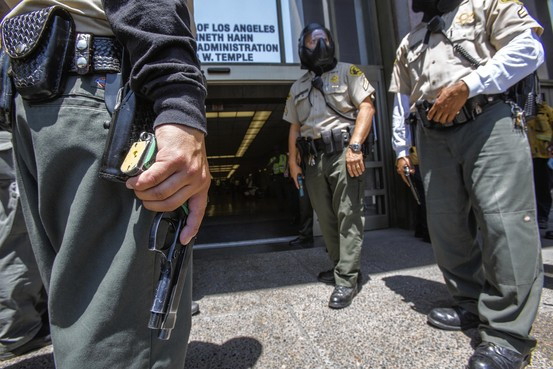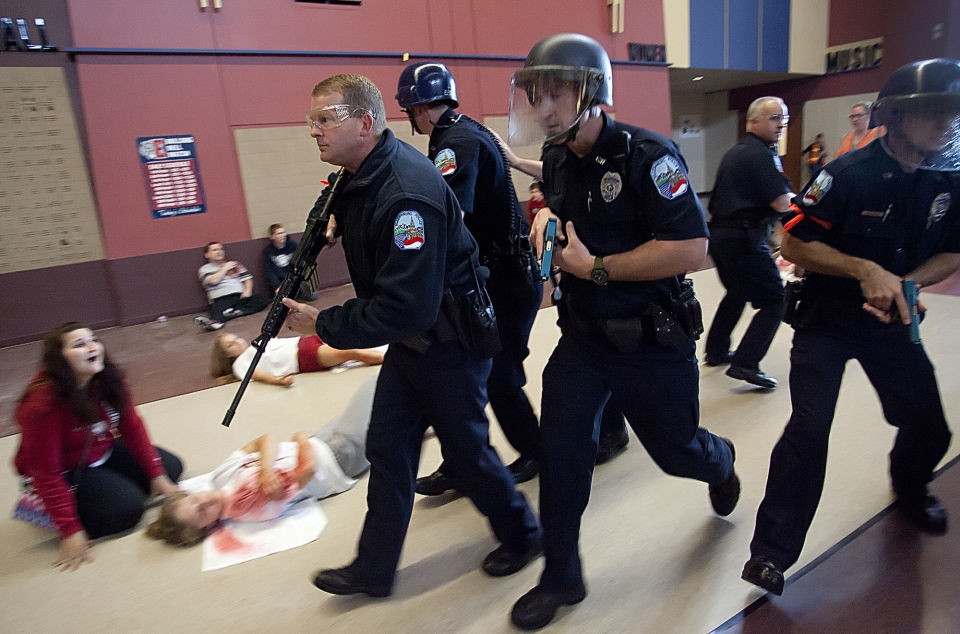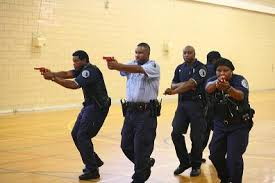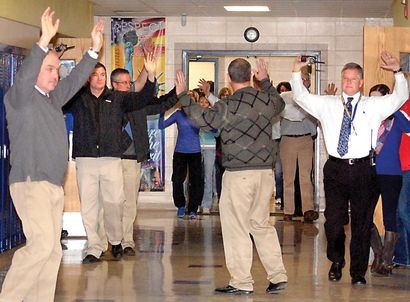More Schools Are Buying ‘Active-Shooter’ Insurance Policies
Districts are buying the coverage, also called “active-assailant” insurance, for legal costs and other expenses in the event of a shooting. More Schools Are Buying ‘Active-Shooter’ Insurance Policies
School administrators consider the likelihood of a shooting real enough that some districts are buying active-shooter insurance.
The coverage, also called “active-assailant” insurance, gained traction in the past year, following several mass shootings. Schools use it in hopes of avoiding litigation and offsetting costs for counseling services, crisis management and added security after an attack.

After a mass shooting at a school, it isn’t unusual for victims and grieving family members to file lawsuits against a school district alleging negligence, including for matters such as failing to provide adequate security or missing warning signs of a would-be-shooter.
After the February mass shooting at Marjory Stoneman Douglas High School in Parkland, Fla., 15 survivors filed a lawsuit in U.S. District Court of the Southern District of Florida in July against several parties, including the school district’s superintendent, law-enforcement officials and Broward County. They seek monetary damages to be determined by a jury and attorney fees for alleged failures to protect students at the school.

Insurance underwriter McGowan Program Administrators, an Ohio-based leader in shooter insurance, has written over 300 active-shooter/workplace violence policies for school districts, charter schools, private schools and universities across the country since 2016, when it started offering the coverage. A company official said the company issued over 60 policies in July, and that it has paid out some policies.
Shooter insurance is considered gap coverage, handling expenses not typically covered under general liability, such as funeral costs and death benefits. Annual premiums can range from about $1,800 for $1 million in coverage for small school systems to about $175,000 for $20 million in coverage for larger ones. Death benefits often are offered up to $250,000 per victim.

George Mocsary, an associate professor at the Southern Illinois University School of Law, said the insurance is priced too high for something that has a “extraordinarily low” chance of happening. The odds of a student in K-12 public school getting killed or injured in a multivictim shooting are about one in 4.8 million a year, compared with one in 700,000 a year of getting hit by lightning, Mr. Mocsary said.
Schools typically carry general liability insurance to cover claims stemming from negligence that results in personal and physical injury, death or property damage.

The School District of Indian River County in Vero Beach, Fla., pays an annual premium of $20,909 for a $3 million policy, which includes a $250,000 per person death or injury benefit after a shooting or other violent act. The insurance covers the district’s schools with 15,000 students and employees. Charter schools aren’t covered.
“We’re really answering the question, `Who’s going to take care of the victims?’ ” said Mr. Marshall.
Last year, the insurance company for Marysville School District No. 25 in Washington state settled a lawsuit for $18 million filed by the families of victims in a school shooting that left four students dead and a fifth critically injured. The lawsuit was settled using the school district’s liability coverage.

Broward County Public Schools, which includes Stoneman Douglas High School, said in an email that the district didn’t have active-shooter coverage before February’s mass shooting. The policy is something that has been and continues to be considered, it said.
Updated: 5-12-2019
Schools Question Whether They Should Keep Teaching Students to Confront Shooters After the deaths of two students, some say children may be too young to make such decisions; praise for those who step forward.
Students across the country are taught what to do in case of an active shooter situation: avoid, barricade and hide and, as a last resort, confront the shooter.
But two school shootings in as many weeks where the students who confronted the shooter were killed are prompting officials to question this practice, or wonder, at the very least, should the risk of doing so be discussed.
School districts across the country are training students to throw laptops, books and other objects to distract shooters, and attempt to subdue them by kicking, hitting or tackling.
“They can sit there and become victims, or they can do something and become a hero,” said Greg Crane, founder of the ALICE training method that partly focuses on countering shooters and is taught in about 5,600 school districts. Parents will “be proud of their kids. They saved lives.”
At STEM School Highlands Ranch near Denver, 18-year-old Kendrick Ray Castillo was killed May 7 when he confronted one of two shooters who are accused of killing him and wounding eight others. A week earlier, 21-year-old Riley Howell died in a shooting at the University of North Carolina at Charlotte while trying to defend fellow students.
A UNC spokeswoman said the school offers ALICE training voluntarily, free of charge, and students are taught as a last resort to use everything at their disposal to fight to stop the shooter. School officials in Colorado didn’t respond to a request seeking comment about safety training. It couldn’t be learned what safety protocols were used in the school.
“Are we creating a generation of martyrs to believe that this is the appropriate response?” said Kenneth Trump, president of National School Safety and Security Services and no relation to the U.S. president. “You’re asking them to make executive-function decisions that even adults under stress struggle with. We want to acknowledge and respect the hero of this, but we have to exercise caution with kids who process things very differently than we do, in terms of this is the expected standard.”
The National Association of School Psychologists said the students who lost their lives should be honored and remembered, but extensive coverage of their acts could be harmful.
“We caution against unintentionally glamorizing the extremely high risk of confronting an armed assailant head on, particularly when it involves youth,” the group said in a statement. “Children and adolescents are impressionable and impulsive by nature. They can believe in their own invincibility.”
The association recommends the popular “lockdown” method, which involves locking classroom doors and getting students low and out of sight in an active-shooting situation. The group said confrontation should be a last resort when face-to-face with a shooter.
Training methods like ALICE, which stands for alert, lockdown, inform, counter and evacuate, in no particular order, have been controversial, mostly for encouraging students to counter if needed. Students are trained to counter by distracting the shooter from taking good aim, such as making noise, throwing objects and then getting away if possible, or attacking. Students also are told to follow their teacher’s directions.
Michael Hinojosa, superintendent of the Dallas Independent School District in Texas, said the student in Colorado who lost his life showed great courage and selflessness, but he doesn’t recommend fighting back. “Too many unknown variables,” he said. “Even well-trained law enforcement and military personnel sometimes do not respond well in these instances.”
Not far away, some school officials have no plans to change their approach.
“Instead of putting them under a table and waiting for their demise, empower them to have the ability to get out,” said Ronny Potts, police chief in the Keene Independent School District in Texas, who has helped train students on the ALICE method. “All of our classrooms have bats in them for the biggest person in the room to swing. We’re buying time for me or other officers to get to them.”
Some schools using ALICE have stocked classrooms with buckets of rocks and canned goods, to hit shooters.
Steve Holley, whose 12-year-old son, Nate, hid in a closet as bullets rang at the STEM school in Colorado, said he doesn’t think praising students will spur others to become martyrs. Speaking of Mr. Castillo, “it was an unconscious act of bravery,” he said.
Updated: 5-27-2022
Uvalde Police Made ‘Wrong Decision’ In Waiting To Storm Shooter, Says Official (19 Students And Two Teachers Were Killed)
Police incorrectly thought no children were at risk despite repeated 911 calls from inside the classroom, says official.
Police who responded to the mass shooting at an elementary school here waited around an hour to enter the classroom where the gunman had locked himself because a commander on scene incorrectly thought no lives were at risk despite multiple 911 calls from children inside, the director of the Texas Department of Public Safety said Friday.
The decision was a mistake and it is unclear how many lives it may have cost, said the director, Steven McCraw, at a news conference. Ultimately 19 children and two teachers were found dead.
The first 911 call regarding the shooter came in at 11:30 a.m. Tuesday, minutes before local police arrived and the shooter barricaded himself inside two connected fourth-grade classrooms at Robb Elementary School, Mr. McCraw said.
From 12:03 to 12:46, 911 dispatchers received numerous calls from within the classroom, including repeated calls from a child whispering that people were dead and begging: “Please send the police now,” Mr. McCraw said.
Meanwhile, at least 19 law-enforcement officers waited in the hallway, because the commander on scene, the school district’s chief of police, believed no lives were at risk and it was better to wait until a tactical team could get keys to the classroom before entering, according to Mr. McCraw. A Border Patrol tactical team ultimately did so, and killed the shooter, at 12:50 p.m., he said.
“The on scene commander at that time believed it had transitioned from an active shooter to a barricaded subject,” Mr. McCraw said. “Obviously, based upon the information we have, children in that classroom were at risk and it was in fact still an active shooter…It was the wrong decision. Period.”
Residents of Uvalde, a city of around 16,000 reeling from Tuesday’s slaughter, reacted with a mixture of anger and sadness to Mr. McCraw’s admission.
“If they had an opportunity to rush in, they should have,” said Roman Garza, a 58-year-old contractor who had three grandchildren at the school during the shooting. “If I met the commander, I would ask him, ‘What happened? What were you waiting for?’”
Friday’s press conference followed days of mounting anger among local residents about the time it took to end the massacre and shifting details from officials about the timeline of events at Tuesday’s mass shooting, the deadliest at a school in almost a decade.
A school security officer was off site at 11:28 a.m., when the gunman, 18-year-old Salvador Ramos, crashed a truck into a ditch outside Robb Elementary School and began shooting at people outside a funeral home across the street, according to Mr. McCraw.
The officer arrived soon after hearing about the incident but mistakenly thought a different person was the gunman and bypassed Ramos, who was then in the school parking lot, intermittently shooting, Mr. McCraw said.
Previously, officials said the security officer had confronted Ramos.
Officials earlier said Ramos was outside the school for 12 minutes before entering. They now believe Ramos was outside the school shooting for about five minutes before going in via a door a teacher had propped open minutes before, Mr. McCraw said.
Ramos walked into the school at 11:33 a.m. and the first police officers arrived two minutes later, by which time he was already barricaded into a pair of connected classrooms, numbered 111 and 112, the DPS director said.
Ramos shot more than 100 rounds in the first minutes after he entered the school. Two of the first responding police officers were wounded as he shot out the door of the classroom at them.
Between 11:51 and 12:05, at least 19 officers and Border Patrol agents had assembled in the hallway outside the classrooms, Mr. McCraw said. At 12:15, members of the Border Patrol tactical team called Bortac arrived.
Meanwhile, 911 operators were receiving calls from within the classroom, the first at 12:03 from a girl who whispered she was in room 112, Mr. McCraw said. At 12:10, she called back and said multiple people were dead. She called again at 12:13 and 12:16, saying that eight or nine students were still alive.
At 12:19, a different girl called. “Another student told her to hang up,” Mr. McCraw said. “At 12:21 you can hear over the 911 call that three shots were fired.”
More calls came over the next half-hour and an operator advised a girl calling to stay very quiet, Mr. McCraw said. One girl asked the operator twice, four minutes apart, to please send the police now.
The noise of the Bortac agents unlocking the door, exchanging fire with Ramos, and ultimately killing him at 12:50 p.m. could be heard on the 911 calls, Mr. McCraw said.
In a sign of the confusion on the ground, a knowledgeable law-enforcement official said Bortac agents arrived to find parents outside the school screaming at them to rush in and they were soon ready to breach the classroom where Ramos was located. But local law enforcement on the scene told them to wait, the official said.
The Uvalde Police Department couldn’t be reached for comment.
Pete Blair, who heads an active shooter training program for police at Texas State University, said if Ramos was firing his weapon from inside the locked classroom, police on the scene should have immediately done everything they could to get inside.
“They are supposed to proceed to the attacker with the intent of distracting, isolating and neutralizing the attacker,” he said. “It was a barricaded person who was actively shooting.”
If it was too difficult to go through the door, Mr. Blair said that officers are supposed to look for another way in, such as through a window.
Consulo Enriquez, a Uvalde resident who attended Robb Elementary and has friends who lost children in the shooting, was shopping at a Dollar General store in town during the press conference in preparation for a vigil Friday evening.
When told the police had admitted to making the wrong decision in how they handled the incident, she was quiet for a moment.
“It’s incredibly upsetting to hear that,” she said. “You can prepare for something like this but when it happens are you going to break or are you going to hold? They broke. They dropped the ball. Lives could have been saved.”
Mr. McCraw also shared details Friday about social-media exchanges from Ramos warning of violence ahead of the shooting. In September of last year, he asked his sister to help him buy a gun. She refused, Mr. McCraw said.
In February, Ramos and three others chatted on Instagram about Ramos potentially being a school shooter, Mr. McCraw said. In early March, he discussed buying a gun in chats on Instagram.
On March 14, Ramos posted on the site “10 more days,” prompting another user to respond: “Are you going to shoot up a school or something?” Ramos replied: “No. Stop asking dumb questions and you’ll see.”
Majik De la Garza, 20, said he was two years ahead of Ramos in school and recently saw a Facebook post with him holding a sliced-up cat in a bag. He said the image surprised him because he had thought Ramos was a normal teenager.
“All that stuff they were saying about how he was bullied, it wasn’t like that,” said Mr. De la Garza. “He would joke around, he was having fun. But that video was dark.”
Mr. De la Garza said he was angry about what he saw of the police response to the shooting in videos online and what he learned Mr. McCraw said Friday.
“There were just so, so many cops there and they blew it,” he said. “This town is never going to be the same.”
Related Article:
Poll: Should Active Shooter Training Be Mandatory On or At:

Leave a Reply
You must be logged in to post a comment.